Bernardino Luini and " Milan's Sistine Chapel"
We left Bernardino Luini in Saronno, from there he apparently returned to Milan in around 1524-1526 and commenced one of his most elaborate and important schemes of interior decoration at the little church of San Maurizio ( Chiesa di San Maurizio al Monastero Maggiore) which was attached to a large monastery of Benedictine nun. San Maurizio is still there and is a hidden gem. San Maurizio is on via Magenta, opposite the Palazzo Litta and now surrounded by upscale shops. Part of the former monastery is now the Archaeology Museum. It appears that San Maurizio and is beautiful interior have been lucky to survive the vicissitudes of the abolition of the monasteries, general neglect, and British bombing during World War 2. Thanks to generous benefactors it has been lovingly restored and is now open to the public thanks to the Touring Club of Italy, it is also free but s so beautiful that some kind of donation should be forthcoming. It now seems to be branded as “Milan’s Sistine Chapel” , perhaps not without hyperbole. If you find your self unable to get a ticker for the Cenacolo, San Maurizio is around ten to fifteen minutes’ walk away and just as rewarding, if not more so.

Chiesa di San Maurizio al Monastero Maggiore on via Magenta
The monastery is originally documented as early as the Carolingian era and partly reused some Roman buildings; even today a polygonal tower, a remnant of the ancient walls of Maximian, and another square one, which was originally part of the Roman circus, are part of the complex. The construction of the existing church next to the Monastery began in 1503, a date engraved on a stone found in the apse. Having lost any document relating to its design, it is attributed by critics to the architect and sculptor Gian Giacomo Dolcebuonoù , assisted by the architect Giovanni Antonio Amadeo, at the time responsible for the construction of the lantern of the cathedral of Milan, and also active at the Certosa di Pavia. The building was completed in just a few years, so much so that in 1509 the first tombstones were already placed there. However, the façade was not completed until 1574 by Francesco Pirovano. The church is divided into two parts, a front, public, hall dedicated to the faithful and a larger, rear hall, reserved exclusively for the nuns of the monastery. The nuns were in no way allowed to go beyond the dividing wall; the doors of communication between the two halls were opened only after the suppression of the convent, in the nineteenth century. They could watch the service unfold, which was officiated in the hall of the faithful, through a large grate placed in the arch above the altar. For this purpose, the floor level in the convent church is about half a metre higher than in the public hall. The grille, which once occupied the entire arch above the altar, was narrowed at the end of the sixteenth century by order of Archbishop Carlo Borromeo, to make the cloistered regime more rigid. In its place was placed the altarpiece with the Adoration of the Magi, which is still in place today. The major enterprise was financed by the powerful Bentivoglio family, to which belonged Alessandro, governor of Milan.
The convent, one of the largest and richest in Milan, was suppressed by decree of the Cisalpine Republic in 1798. It was later used as a barracks, a girls' school, and a military hospital during the nineteenth century, when the main cloister and the connected buildings were demolished for the opening of Via Luini and Via Ansperto. Following the bombings of the Second World War, the second cloister was also demolished, and the complex was used as the headquarters of the Civic Archaeological Museum of Milan. The church has undergone considerable restoration work: in 1964 interventions were carried out to save some of the frescoes compromised by humidity. In 1986 an anonymous bequest made it possible to begin the restoration of the frescoes. The first to undergo the intervention were those of Bernardino Luini on the transversal wall of the church of the faithful. Subsequently, other donations allowed the restoration of the chapels, while the contribution of the Banca Popolare di Milano made it possible to restore most of the frescoes of the first tier.
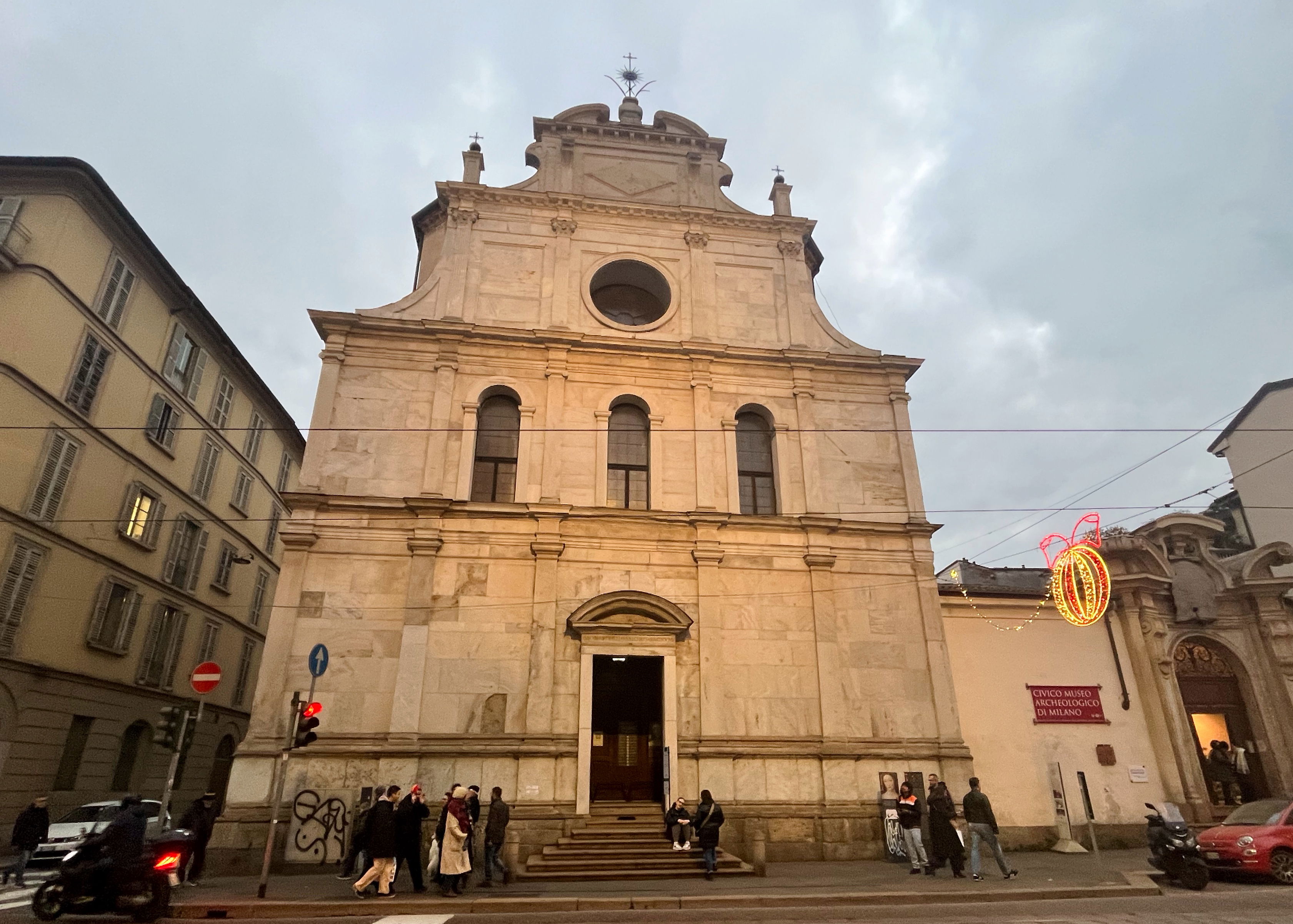
The front view of Chiesa di San Maurizio al Monastero Maggiore
In the vaults lie the remains of Giovanni Bentivoglio, who had ruled Bologna for nearly half a century. In 1506 Pope Julius II. made war against him, in continuation of his masterful idea to rid himself of the various powers under which the temporal power of the Papacy was almost overwhelmed. Events favoured the Pope. He conquered first Perugia and then Bologna, drove Bentivoglio from the throne and a few years after united the state of Bologna to the papal dominions. Meanwhile, Giovanni Bentivoglio fled to exile in Milan. Het sent his son Alessandro to France to plead with Louis XII for help against the Pope. However, friendship of the ambitious Pope was of too great importance to Louis and the Emperor for either of them to help Bentivoglio. Louis XII had him arrested instead and imprisoned in the Castello Sforza. Bentivoglio died at Milan at the age of seventy, imprisoned , excommunicated and with Alessandro still absent pleading for help for a lost cause.
Alessandro returned to in Milan and married Ippolita Sforza in 1492, her father, Carlo Sforza, was an illegitimate son of Galeazzo Maria Sforza, Duke of Milan and Lucrezia Mandriani, while his mother Bianca Simonetta was the Lady of Galliate. The couple had one daughter, Alessandra, who took the veil in the same church, and entered the monastery with which it was connected, later becoming the Abbess. Luini was selected by Bentivoglio and his wife to carry out the frescoes in the church where they hoped to be buried and which they thought would serve to perpetuate their memory. Since the Bentivoglio/ Sforza were a very well-connected power couple at the time the commission Ippolita Sforza, was a welcome and important one.
Luini’s frescoes cover the screen or eastern wall of the church, which separates the part of the church open to the faithful public from the parts open to the nuns. The altarpiece itself is not Luini’s work, but his frescoes surround on either side and above right up to the baldacchino ( canopy) and rood crucifix.
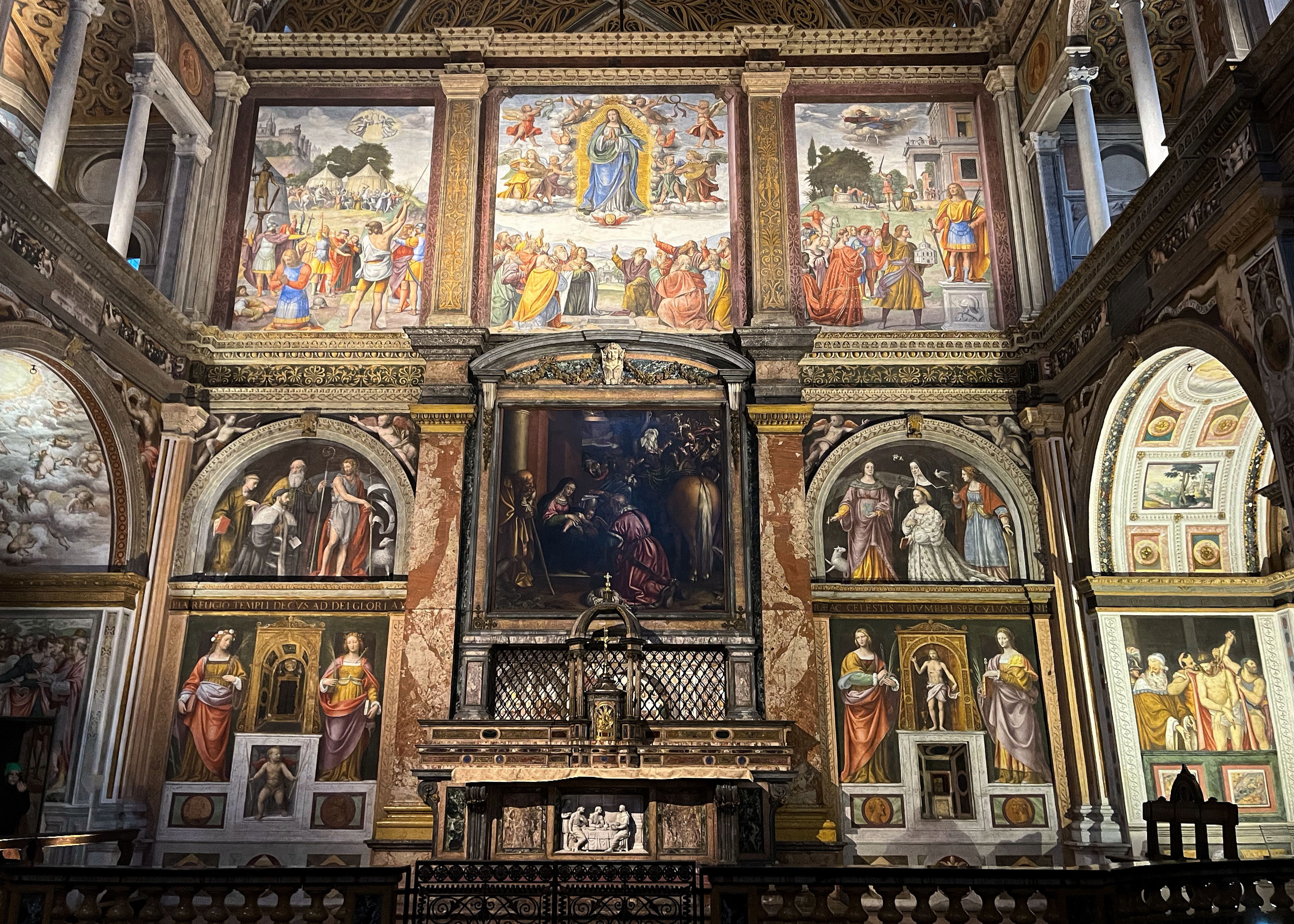
Luini's frescoes in Chiesa di San Maurizio al Monastero Maggiore
On the right is a lunette representing Alessandro (who was at that time about fifty-four) kneeling and holding a book of devotions in his hand, while around him are grouped St Benedict, St John the Baptist with his lamb, and St John the Divine.
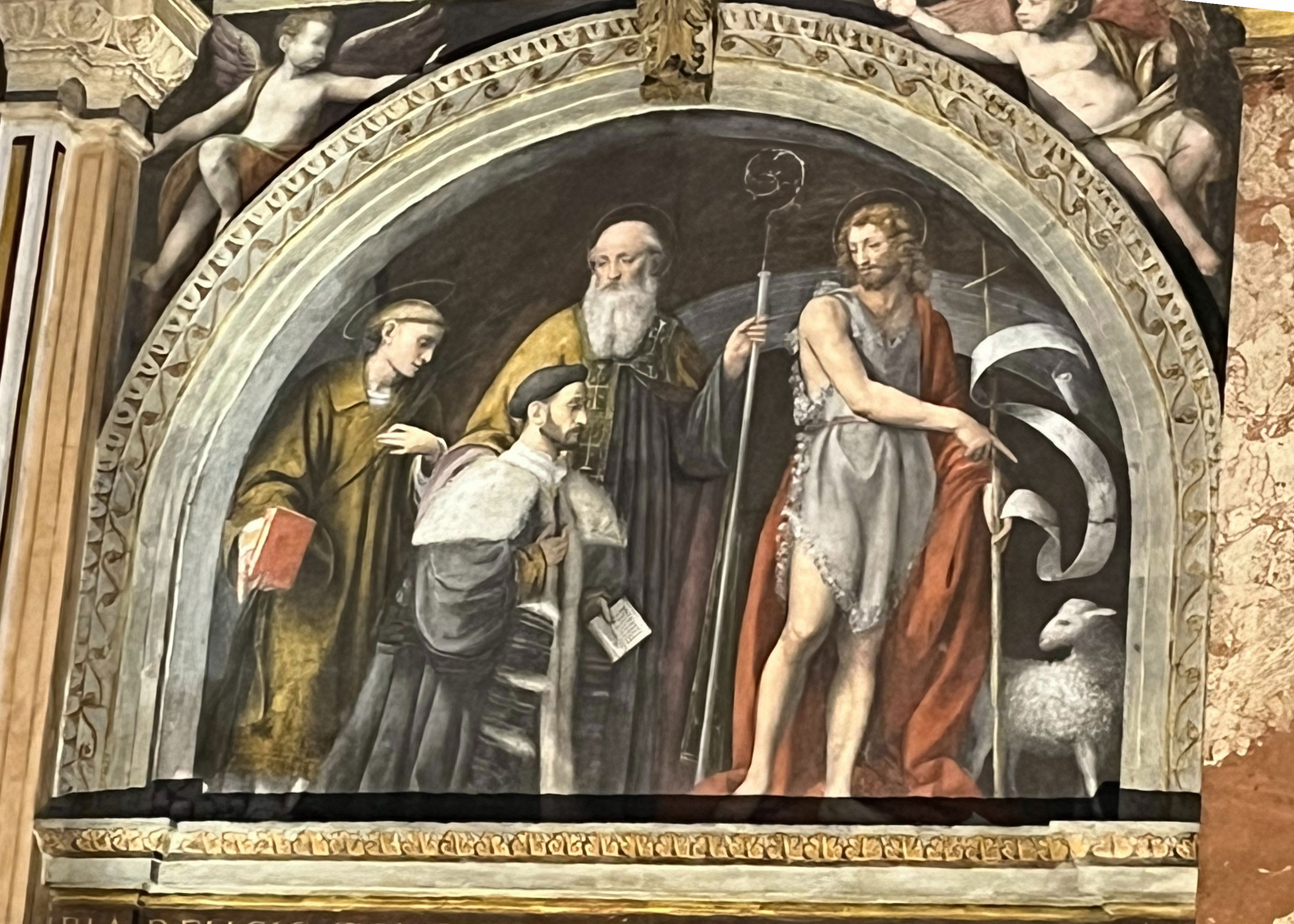
Alessandro Bentivoglio with St Benedict, St John the Baptist with his lamb, and St John the Divine.
Below this lunette, and divided by borders of decoration, are the life-sized figures of two saints standing on either side of the tabernacle. One is St Justina of Padua, with her palm and book, and denoted by the sword which pierces her breast. St. Justina of Padua was a virgin of noble birth in the city which claims her patronage. Born in Padua about the middle of the first century, her father Vitalian was a rich nobleman and prefect of Padua. Her parents were converted to Christianity by the preaching of Saint Prosdocimo, and not having been blessed with children up to that time, they received Justina in answer to their prayer
.She was devoted to religion from her earliest years and ultimately she took the vow of perpetual virginity. At this time arose the persecutions of the Christians by Nero, and Maximian the prefect who had succeeded Vitalian, proved himself particularly brutal. As Justina would visit the prisons to comfort and encourage the Christians there, Maximian ordered her arrest. Brought before Maximian, he was struck by her beauty and endeavoured by every means to shake her constancy. However, she remained firm against all attacks and the prefect had her executed by sword.
The other is either St. Ursula or St Dorothea ; she also bears a palm and a book, and her general appearance seems to denote her as St Dorothea. Below the tabernacle and between the saints is a cherub, bearing two symbolic torches.
On the opposite side is a similar arrangement In the lunette is Ippolita Sforza, also kneeling and holding a book of devotions, and around her are three female saints, St. Scholastica, St Agnes, and St Catharine. The balance with the other lunette is accentuated by the fact that in this one there is also a lamb, denoting the presence of St Agnes. A fresco of Jesus takes the place of the tabernacle in the corresponding fresco, and below this is the same child cherub, this time in sadness and mourning because the lights he was bearing so joyously in the other fresco have now gone out for ever.
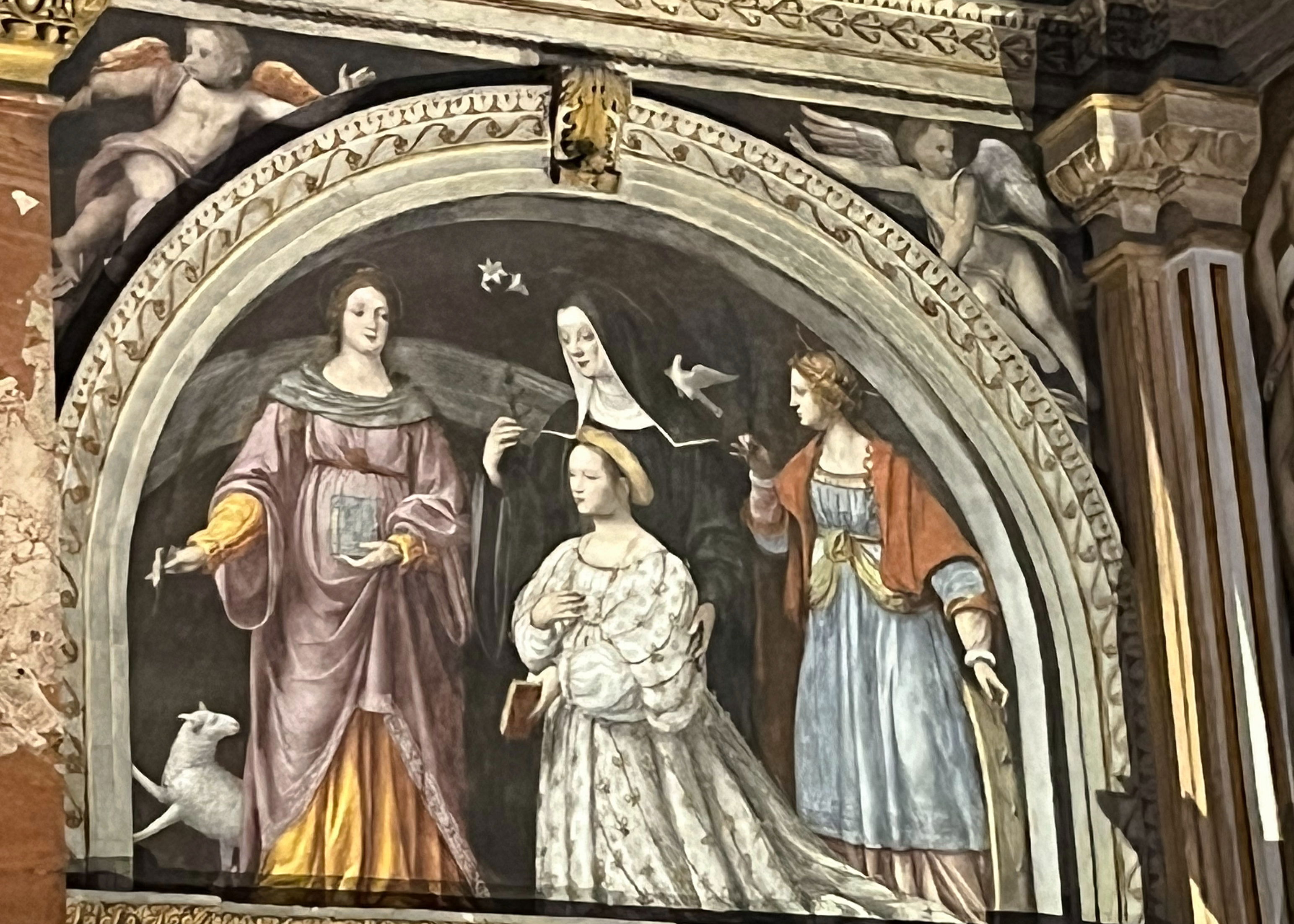
Ippolita Sforza, with St. Scholastica, St Agnes, and St Catharine.
According to the traditional story, Lucia was born to rich and noble parents in Syracuse in 283. Her father was of Roman origin,[but died when she was five years old, leaving Lucy and her mother without a protective guardian. Her mother's name, Eutychian, seems to indicate that she came from a Greek background. Like many of the early martyrs, Lucia had consecrated her virginity to God, and she hoped to distribute her dowry to the poor. However, Eutychia arranged Lucy's marriage to a young man of a wealthy pagan family. Meanwhile severely unwell, Eutychia made a pilgrimage to the shrine of St. Agatha at Catania. While they were at Catania , St. Agatha came to Lucia in a dream and told her that because of her faith, her mother would be cured, and that Lucia would be the glory of Syracuse. With her mother cured, Lucia took the opportunity to persuade her mother to allow her to distribute a great part of her riches among the poor. Eutychia suggested that the sums would make a good bequest, but Lucy countered,
"...whatever you give away at death for the Lord's sake you give because you cannot take it with you. Give now to the true Savior, while you are healthy, whatever you intended to give away at your death."
News that the patrimony and jewels were being distributed came to Lucy's betrothed, who denounced her to Paschasius, the Governor of Syracuse. Paschasius ordered her to burn a sacrifice to the emperor's image. When she refused, Paschasius sentenced her to be defiled in a brothel. Tradition states that when the guards came to take her away, they could not move her even when they hitched her to a team of oxen. Bundles of wood were then heaped about her and set on fire, but would not burn. Finally, was killed by a sword to her throat. According to later accounts, before she died, she foretold the punishment of Paschasius and the speedy end of the persecution, adding that Diocletian would reign no more and Maximian would meet his end. This so angered Paschasius that he ordered the guards to remove her eyes. An alternative version has Lucy taking her own eyes out in order to discourage a persistent suitor who admired them. When her body was prepared for burial in the family mausoleum it was discovered that her eyes had been miraculously restored. This is one of the reasons that Lucy is the patron saint of those with eye illnesses.
On the top right is a scene representing the attack upon St. Maurice, and the martyrdom of the saint, who kneels in the foreground and is being beheaded by a huge executioner. According to legend, Maurice was an Egyptian, born in AD 250 in Thebes. Maurice became a soldier in the Roman army. He rose through the ranks until he became the commander of the Theban legion, thus leading approximately a thousand men. He was an acknowledged Christian at a time when early Christianity was considered to be a threat to the Roman Empire. The legion, entirely composed of Christians, had been called from Thebes in Egypt to Gaul to assist Emperor Maximian in defeating a local uprising. The Theban Legion was dispatched with orders to clear the Great St Bernard Pass across the Alps. Before going into battle, they were instructed to offer sacrifices to the pagan gods and pay homage to the emperor. Although Maurice pledged his men's military allegiance to Rome. He stated that service to God superseded all else. He said that to engage in wanton slaughter was inconceivable to Christian soldiers and that his men refused to worship Roman deities. When Maximian ordered them to murder local Christians, they refused. Ordering the unit to be punished, Maximian had every tenth soldier killed. Maurice encouraged his men to disobey further or4ders and a second decimation was ordered. Maximian ordered all the remaining members of the legion to be executed. The place in Switzerland where this occurred, known as Agaunum, is now Saint-Maurice, , site of the Abbey of St. Maurice. Traditionally , Maurice had ben portrayed as an African, interestingly in Luini’s depiction St Maurice is portrayed as white.
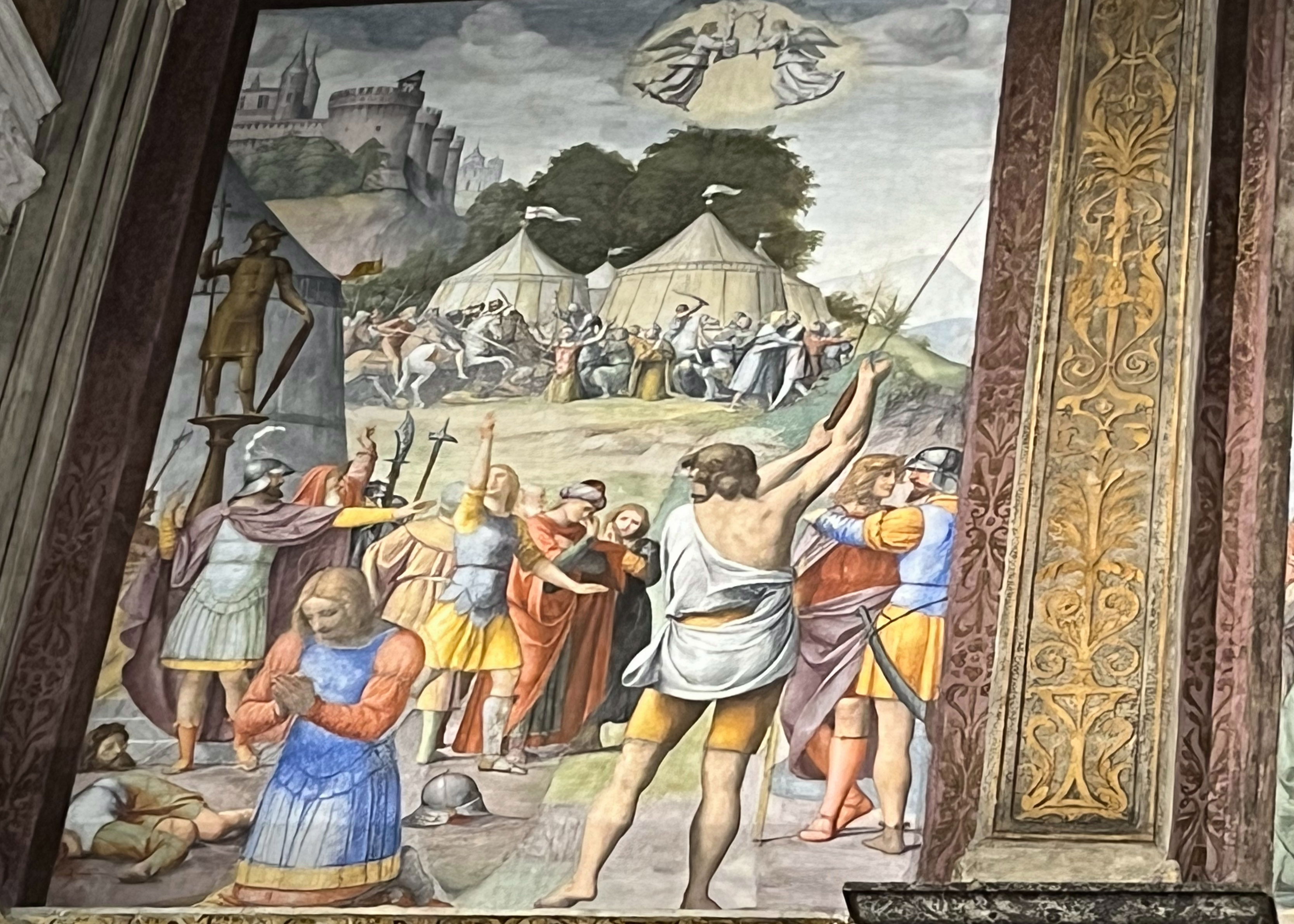
The martyrdom of San Maurizio
On the left is a similar fresco representing in the fore-ground King Sigismund presenting the church to St Maurice, who in this picture stands aloft on a pedestal. In the background King Sigismund himself suffers martyrdom by the sword. Sigismund was King of the Burgundians from 516 until his death in 524 He was the son of King Gundobad and Caretene. He succeeded his father in 516. Sigismund and his brother Godomar were defeated in battle by Clovis's sons, and Godomar fled. Sigismund was captured by Chlodomer, King of Orléans, where he was kept as a prisoner. Sigismund was a student of Avitus of Vienne, the Chalcedonian bishop of Vienne who converted Sigismund from the heretic Arian faith of his Burgundian forebears Sigismund was inspired to found a monastery dedicated to Saint Maurice at Agaune ( now St- Maurice) in Valais in 515.In 523, Clotilde, daughter of Chilperic II of Burgundy who had been slain by Sigismund's father Gundobad in 493, took revenge for the murder of her father, when she incited her sons against Sigismund, and provoked the Burgundian War, which led to Sigismund's deposition and imprisonment, and his assassination the following year. In 523, the Kingdom of the Burgundians was invaded by the four Frankish kings, Chlodomer, Childbeert I, Clotaire I and Theuderic I, children of Frankish king Clovis I and Sigismund's first cousins once removed by Clotilde. Sigismund and his brother Godomar led the Burgundian defence but lost the battle. Godomar fled while Sigismund put on a monk's habit and hid in a cell near his abbey. He was captured by Chlodomer, King of Aurelianum (modern Orléans), beheaded and his body thrown in a well.

King Sigismund presents the monastery of Agaune to San Maurizio
According to Williamson.
“These three pictorial frescoes are full of movement and vivacity, the figures are well drawn, and the faces admirably painted, but all reveal the lack of power in composition, the lack of coherence in grouping that distinguished Luini even at his best
The lunettes below them, and the standing figures are far finer than the pictorial work. There is a majestic dignity about all these saints that is very impressive and delightful.
The colour scheme is most harmonious, and all the frescoes are in very fair preservation. The selection of the saints is instructive. The house was a Benedictine one for women, hence St Benedict and St Scholastica are represented"
Luini also fulfilled his commission on the monastery side. A door to the left of the altar reaches the nun's choir is reached, and here, on the back of the screen, is a further series of frescoes, for the most part in very bad condition. Before the restoration at the time, Williamson was writing, many of them were almost invisible, and doors have been cut through two of them causing serious damage. One of the most beautiful, representing the marriage at Cana in Galilee, According to Williamson ; “It is not an ordinary representation of the miracle, but a mystical one, and evidently symbolized to the nuns the Divine union of Christ with the consecrated religious, The bride is a nun and the bridegroom St Maurice, and what remains of the fresco reveals it a graceful and well grouped work. “ Amongst other scenes on this side of the church are The Betrayal, The Mocking of Christy The Crucifixion, The Deposition, The Scene in the Garden of Gethsemane, The Resurrection, the Noli me tangere. Nine frescoes in all, with 140 figures in them, but every one seriously damaged.
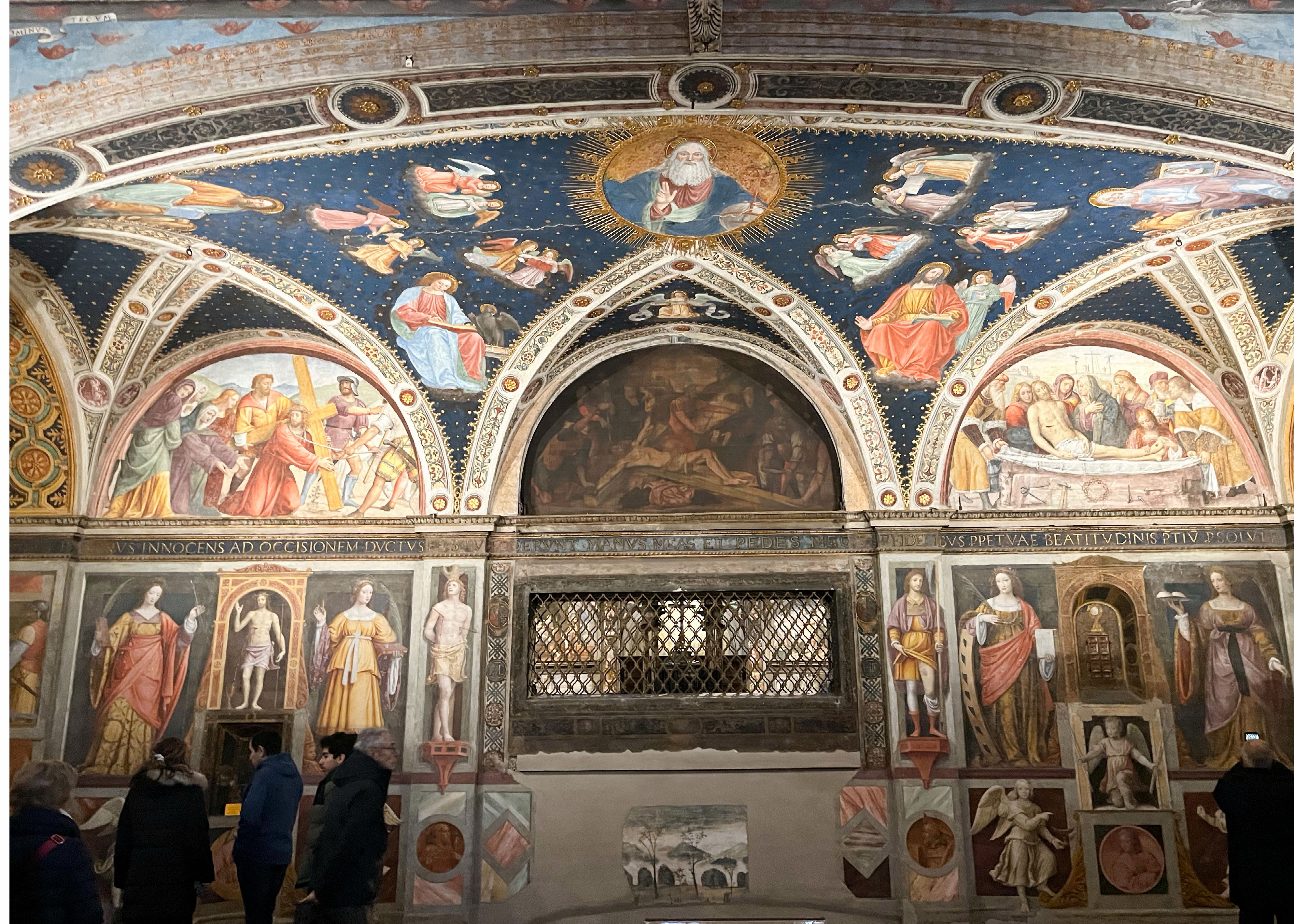
Frescoes on the Nun's cloister - with St Apollonia, St. Catharine, St Roch, St Sebastian, St Agatha and St Lucia . The grill through which the nuns could look into the public part of the church is in the middle
Below them is another series of life-sized erect figures including his favourite saints, St Apollonia, St. Catharine, St Roch, and St Sebastian, ,( all of whom had been depicted in the Saronno frescoes) as well as St Agatha and St Lucia .

St Catherine and St Agatha
It was this St Catherine, that the British writer and artist John Ruskin spent hours copying in a visit in 1862. Unfortunately for Ruskin iphones had not been invented the time. Ruskin ( who we last met in Baveno) was a big Bernardino Luini fan. It is worth quoting Ruskin at length
“Because Leonardo made models of machines, dug canals, built fortifications, and dissipated half his Art- power in capricious ingenuities, we have many anecdotes of him, but no picture of importance on canvas, and only a few withered stains of one upon a wall. But because his pupil, or reputed pupil, Luini, laboured in constant and successful simplicity, we have no anecdotes of him, though hundreds of noble works. Luini is, perhaps, the best central type of the highly trained Italian painter. He is the only man who entirely unites the religious temper which was the spirit-life of Art, with the physical power which was its bodily life. He joins the purity and passion of Angelico to the strength of Veronese; the two elements, poised in perfect balance, are so calmed and restrained each by the other, that most observers lose the sense of both. The artist does not see his strength, because of the chastened spirit in which it is used, and the religious visionary does not recognise his passion, by reason of the frank human truth with which it is rendered. He is a man ten times greater than Leonardo;—a mighty colourist, while Leonardo was only a fine draughtsman in black, staining the chiaroscuro drawing, like a coloured print. He perceived and rendered the delicatest types of human beauty that have been painted since the days of the Greeks, while Leonardo polluted all his finer instincts by caricature, and remained to the end of his days the slave of an archaic smile; and he is a designer as frank, instinctive, and exhaustless as Tintoret, while Leonardo’s design is only an agony of science, admired chiefly because it is painful, and capable of analysis in its best accomplishment. Luini has left nothing behind him that is not lovely, or that is accusable in any definite error; but of his life I believe hardly anything is known beyond remnants of tradition which murmur about Lugano and Saronno, and which remain ungleaned."
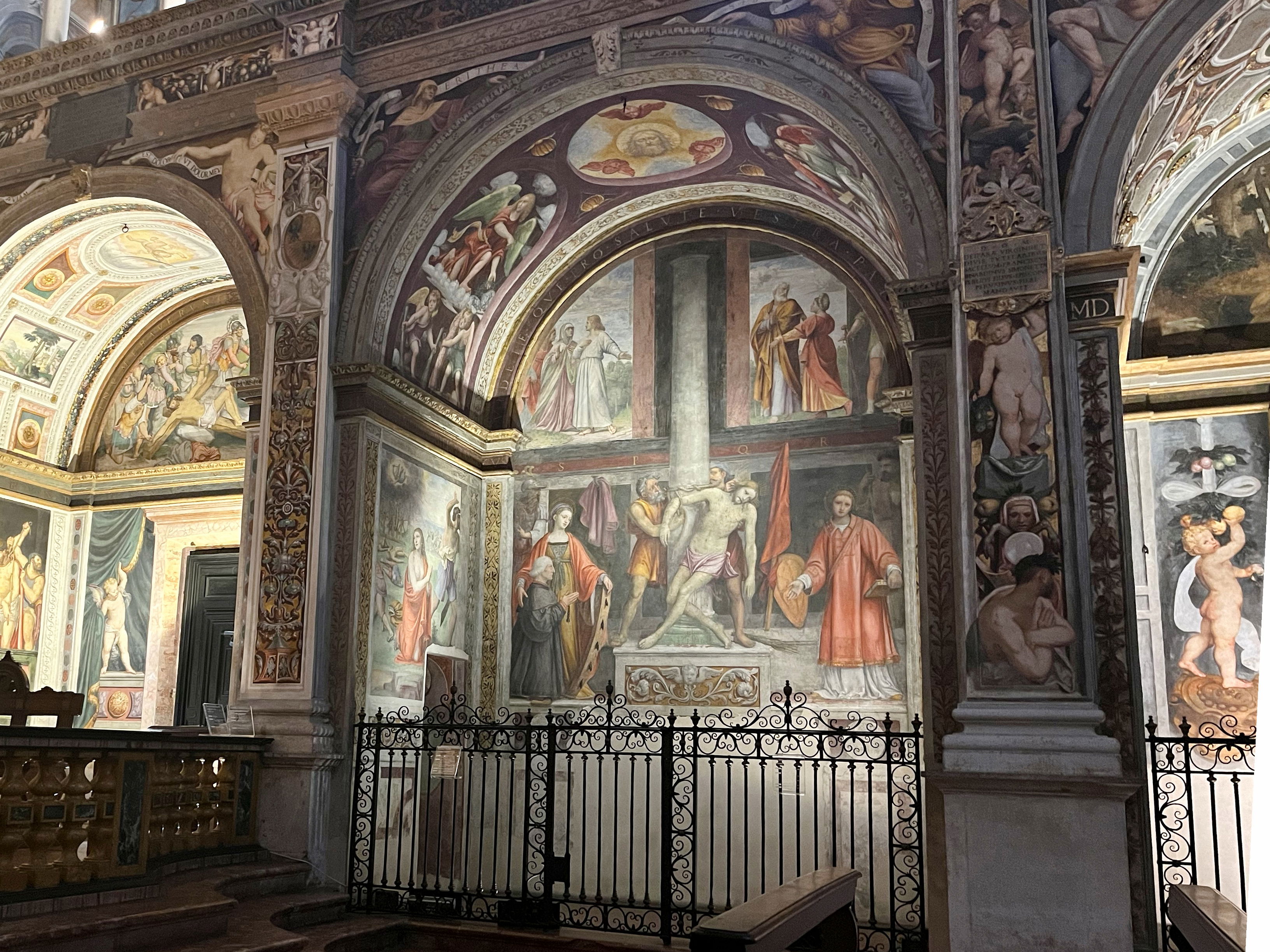
The Besozzi Chapel
After working in Lugano , in 1529 Luini was back in Milan working again in the church of San Maurizio. This time his commission was to decorate one chapel, and the donor of the work and founder of the chapel was one Francesco Besozzi, a well-connected notary in the city . Luini’s work was completed, by the 15th of August, 1530, but unfortunately Besozzi . died in 1529, and did not live to see the l frescoes executed in his name- It is believed that Besozzi was well connected with the monastery of Santa Caterina Sassoballaro on the shores of Lake Maggiore, hence the significance of the St Catharine representation. Besozzi had survived the 1524 plague ( the plague of Charles V to distinguish from earlier and later plagues) which had devastated the city ( some estimates were that half the population died). Maybe it was fortuitous or coincidental that Luini had spent the plague years outside Milan. For the altar-piece Besozzi had specified a representation of the flagellation Luini did not attempt to represent it in customary form. Instead, he chose to depict the unbinding of Jesus from the column after the scourging had taken place. Perhaps to avoid the creation of any feelings of horror or repulsion in the minds of those who worshipped at the altar. The Roman soldiers are loosening the ropes that bound the victim to the column, and Jesus on the point of collapsing is being roughly supported by one of the men.

Bernardino Luini fresco of the flagellation with St Catherine and St Lawrence
The bodily weakness of Jesus , almost triumphing for a moment over his intense mental courage, is finely expressed, and to those who served or knelt at the altar the picture would always be an enkindling of deep sympathy, of profound pity and compassion, and of wonder at the sorrowful sight. Close at hand stands St Lawrence, robed in a deacon's tunicle (dalmatic) and wearing the stole across his breast. With one hand he carries a clasped book and a palm, the other hand he stretches out, pointing to Jesus with a piteous expression of grief. Some commentators speculate thar it is not actually supposed to be St Lawrence , but rather St Stephen. Since they both lived around the same m and were both martyrs. It probably does not matter which one of them it was supposed to be.
On the other side is a majestic figure of St. Catharine leaning upon her wheel. She lays her hand tenderly upon Francesco Besozzi, who, is dressed in simple notary robes , and holding his rosary between his clasped hands, kneels humbly by her side, gazing in great reverence at the figure of Christ Behind the saints are tall, armed warriors, and nearby are the clothes of the executioners and the vesture of Christ, while on the floor are the scourges.
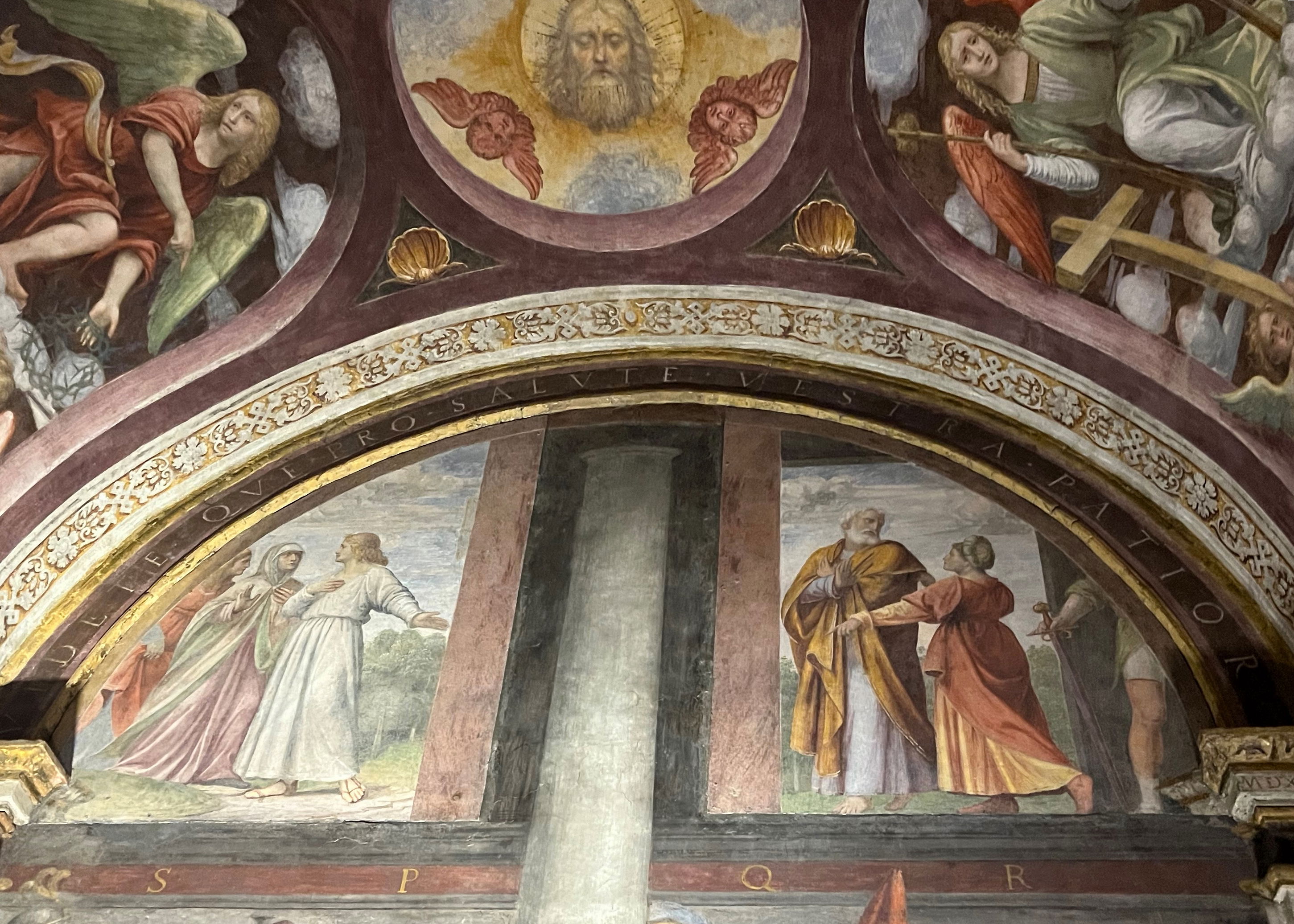
Detail from the Besozzi Chapel with Noli mi Tangere and St Peter approached by Mary Magdalene
High up above this representation are two smaller scenes, divided by the column which passes right through the picture. These two smaller pictures, each containing only two figures, appear to refer to the Easter Resurrection. In one St. Peter is approached by Mary Magdalene, who points to the open tomb and the Roman soldier In the other Our Lord appears to Mary in the garden risen form and forbids her to touch Him. ( NOLI MI TANGERE).
In the King James Version of the Bible the text reads:
“Jesus saith to her, Touch me not; for I am not yet ascended to my Father; but go to my brethren, and say to them, I ascend to my Father and your Father, and to my God and your God.”
The sides of this chapel are occupied by two frescoes depicting the legend of St. Catharine. In one fresco is seen in the distance the destruction of the four wheels by the angel of God, and the slaying of the executioners and three thousand people by the fragments that flew around. In the foreground is St. Catharine kneeling in prayer, asking that she may be strengthened for the terrible death that at that moment was before her.
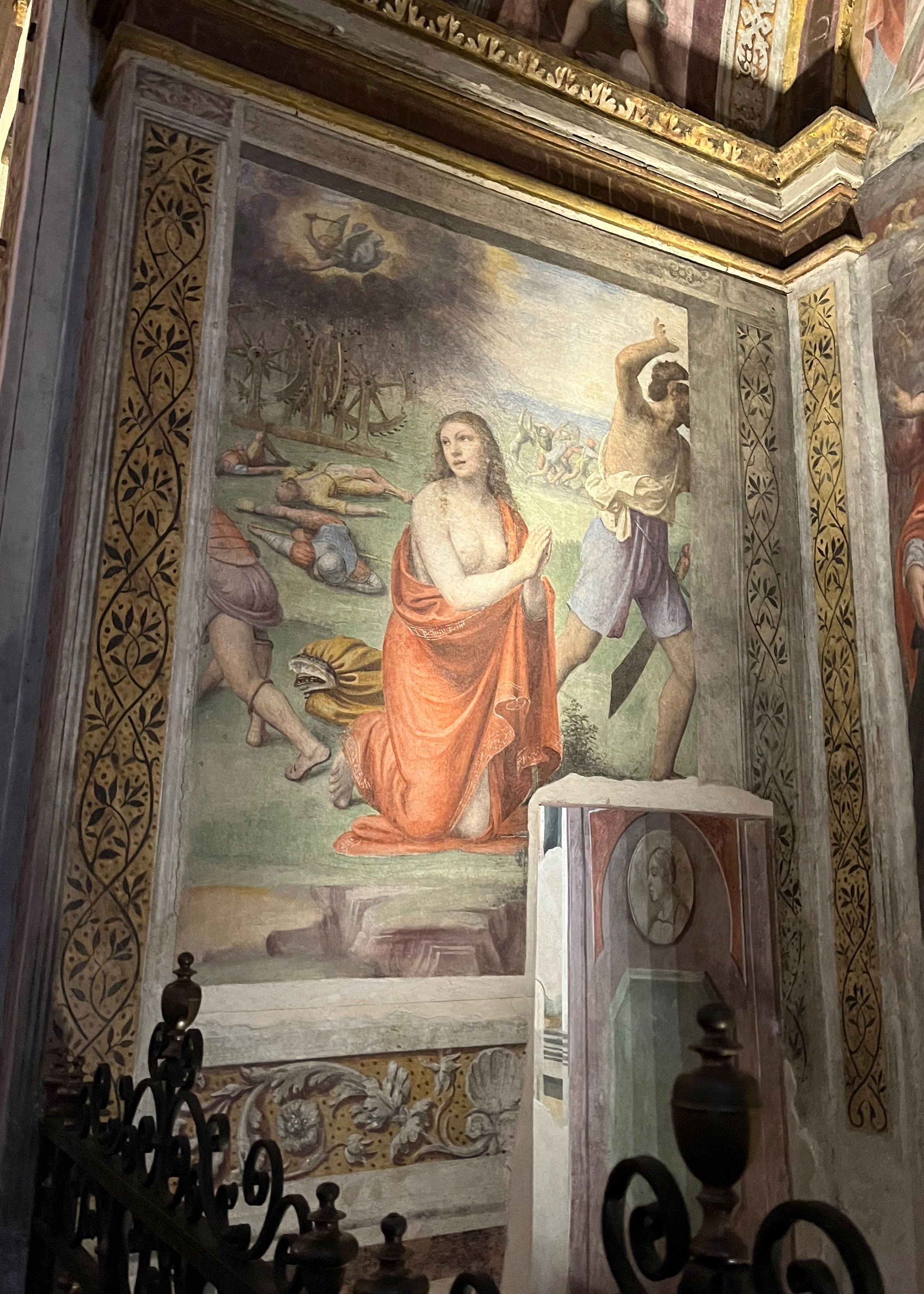
St Catherine and the broken wheels
The other fresco depicts the decapitation and burial of St Catharine. After the failure of the wheel torture The Romans decided to behead her anyway. The saint kneels in the foreground , while above her towers a gigantic executioner brandishing the sword with which he is about to martyr her. Close by are Roman guards. In the distance is Mount Sinai transfigured in burning light, and in the midst of the light angels are placing the body of St. Catharine into the marble tomb prepared for it .
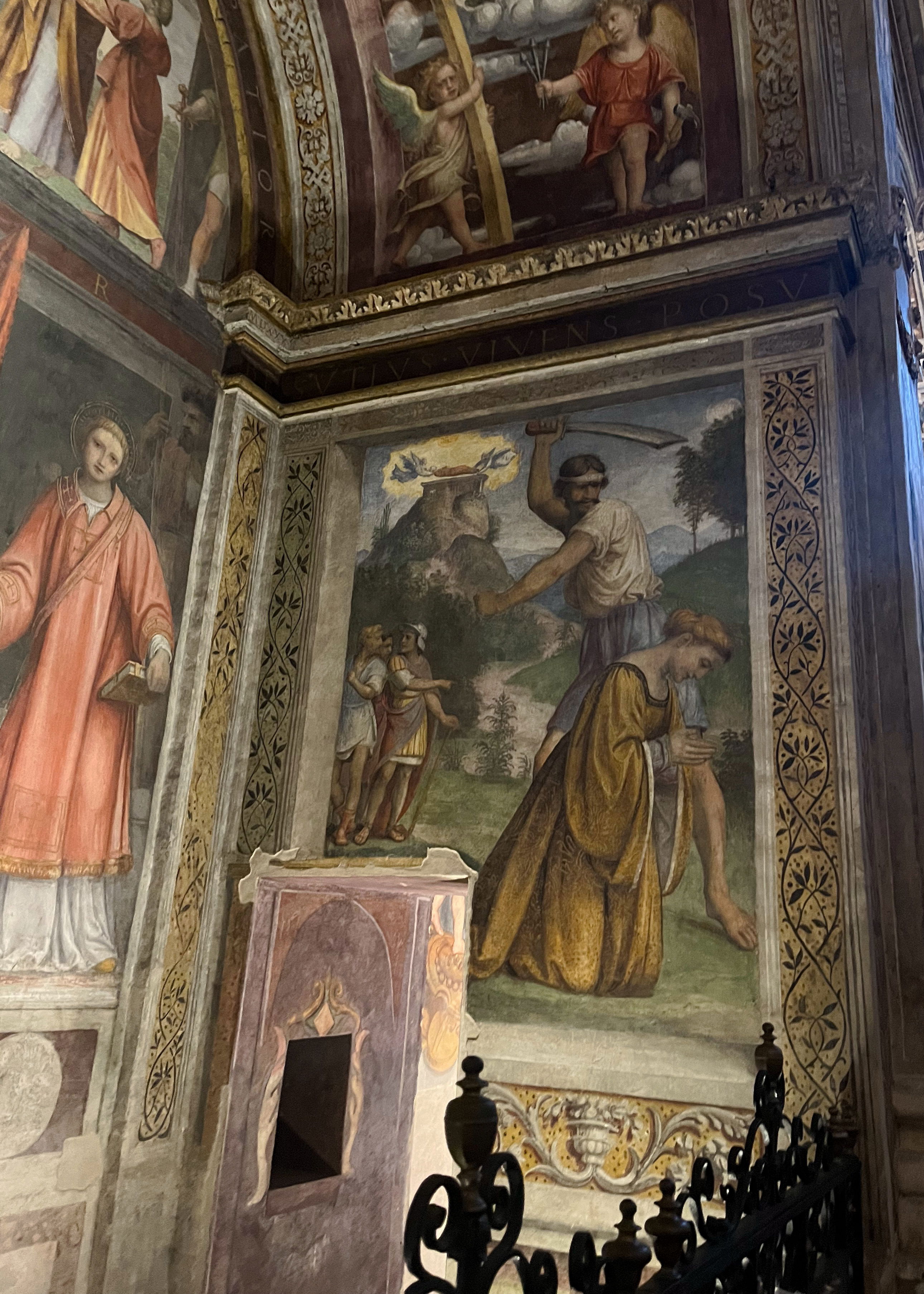
The decapitation of St Catherine
The curious feature about these two frescoes is that apparently, the face of St Catharine is that of one of the most celebrated and most wicked of women of the time. Bianca Maria was the beautiful daughter of one Giacomo Scappardone by a Greek wife. She married first Ermes Maria Visconti, , but he died and she retired to Casale di Monferrato Later she became the wife of the René de Challant , but after a few months of married life they had a serious quarrel, and the Countess fled to Pavia, where, according to Bandello, she lived a life "over free, and little honest." One of her lovers was Ardizzino, Count of Mavino who, was violently in love with her, but she gave him up and attracted to herself Sanseverino, Count of Gaiazzo. Having won his affection and obtained his promise to gratify all her wishes, she tried to persuade him to kill Ardizzino, whom now she thoroughly hated. He pretended to assent, but did not intend to carry out her desire, and left her in horror. She then returned to the desire for Ardizzino, and, in order to be revenged upon Sanseverino, used her utmost power to attract back again her previous lover, and then having won him to her side again, proposed to him to kill Sanseverino. She succeeded no better with him, as he was likewise horrified at her cruelty and fled from her, and meeting Sanseverino afterwards, they revealed to one another the manner in which each had been cajoled to kill the other.

Was the model for St Catherine, the notorious Bianca Maria Scappardone
Still the revenge of this terrible woman was hot and burning. A foolish youth, a Sicilian, one Pietro di Cardona, fell within her toils, and she worked her wicked will upon him. A long and untrue story of the previous cruelty of Ardizzino inflamed his anger, and to win her enduring affection he undertook to execute her wishes. With a band of twenty-five men he met Ardizzino, Count of Mavino, and his brother Carlo, and set upon them and murdered them both. The Duke of Bourbon, who was at that time the titular ruler of Milan, had Pietro arrested and thrown into prison. Then Sanseverino came forward and told the whole story, and the city rang with the intelligence of the crimes of this famous beauty. Pietro by some connivance was allowed to escape from prison, as it was evident that he was only a tool in the hands of his mistress, and a man of very weak intelligence, but the Countess of Challant was beheaded as the penalty of her crime. This was the story that was in every one's mouth at the time Luini was working at the Besozzi Chapel, and he made use of the beauty of the wicked Countess and painted her fascinating features in his representations of St. Catherine, and so perpetuated her memory and the story of her crime.
In the roof of the chapel appear the two sibyls, Agrippa and Erithrea, and angels bearing the emblems of the Passion, the crown, the nails, the spear, the sponge, and other emblems, and these mighty spiritual beings are gazing down upon the scene of Christ unbound from the column, and their faces are expressive of great pity and of comfort.

The sibyls - detail from the Besozzi Chapel
The whole motif of the decoration of this chapel, ( apart from the use of the Countess of Challant as a model) seems to be that of suffering without fault, and of heavenly comfort given to the sufferer. The sufferings of Jesus, of St. Catharine, of St Lawrence, of the Apostles at the empty tomb, of Mary Magdalene in the Garden, were all meritorious sufferings, not the result of the sin of the sufferer, but for the purification of the soul. All these sufferings were blessed from heaven, all the sufferers received heavenly comfort and eventually the reward of martyrdom, and this scheme of thought seems to be the idea upon which the selection both of the frescoes and of the standing figures is based.
His work in Milan completed, Luini apparently returned to Lugano.
Further Reading